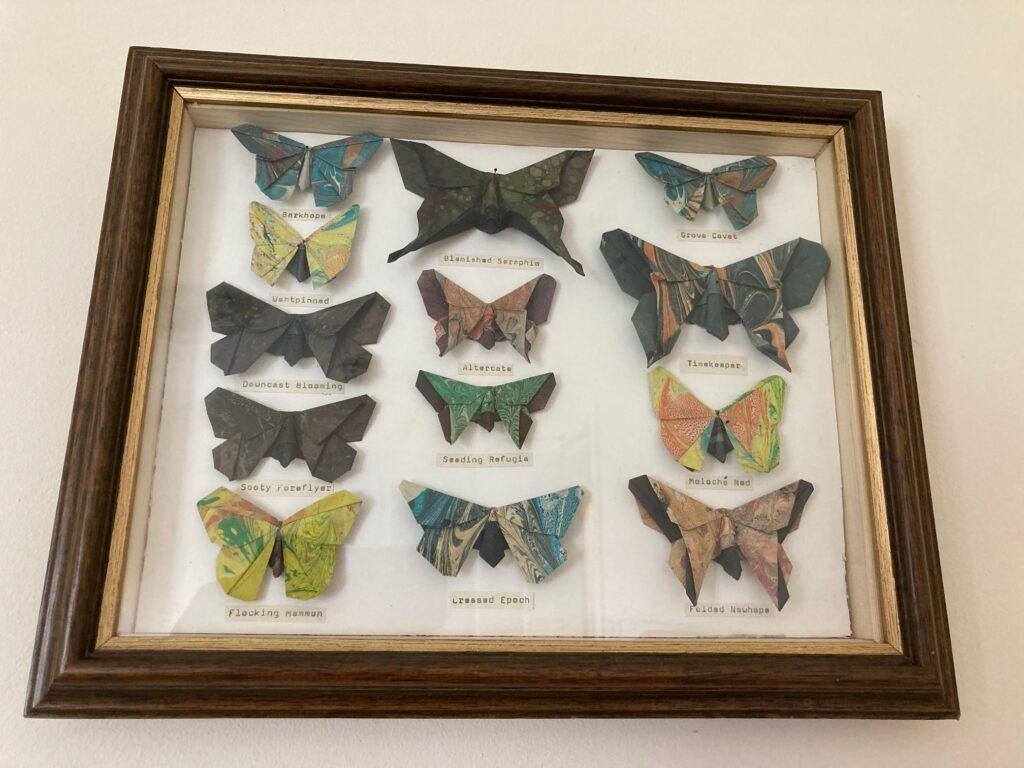
The work of a long-forgotten Edwardian artist has been discovered in an attic in the Highlands of Scotland.
Sir Christopher Spink, an artist who created butterfly origami sculptures from his home in the Highlands, is thought to have lived from 1895 to 1925.
He travelled the world in search of inspiration for his art work, following in the footsteps of his heroine Maria Sibylla Merian (1647 – 1717) to South America, where he discovered the Creased Epoch and the utterly unknown Variegated Plumecast.
Sir Christopher was frustrated that his artwork involved the killing of rare butterflies and so in 1921 he began creating the first of many extraordinarily beautiful origami sculptures, in part inspired by his friend, Josef Albers (1888 – 1976) who taught Spink when he studied at the highly regarded Bauhaus design school in Germany. He captured the only ever sighting of the Dogeared Princeling of Argentina before it became extinct in 1930 and the Trailing Brightpath of the Amazon, never witnessed since. Sir Christopher Spink died in 1925, leaving behind only his faithful companion, Otto, his dog.
The eccentric Sir Christopher was famous in the Highlands during the 1920s, not only as an artist but also for the entertainment he gave to his visitors who included artists and writers from around the world. A local reporter of the time recalled seeing Sir Christopher riding on his Penny Farthing while also juggling in Beauly square. He was also known to sing loudly while out walking his dog. The aristocrat suffered from what would now be known as dyspraxia but the condition was then completely unknown. It is thought that this is what compelled him to begin to learn to juggle and later, to practise paper origami.
Thanks to the work of Moniack Mhor writer’s centre in Inverness-shire, Sir Christopher Spink’s work has been rediscovered and an exhibition of his work has begun at the centre.
Claire Daly, Centre Manager said, “We were busy clearing out room 8 in preparation for our International Residency when we spotted a hitherto unknown opening, previously hidden by plasterboard, to the eaves space of our 18th century building. When the lock was prised open, we found these wooden boxes containing these marvellous treasures, covered in dust though they were, we couldn’t believe it when we discovered these stunning creations. We began research on Sir Christopher Spink and now know that, as probably the world’s first vegan taxidermist, long before the word vegan even existed, he deserves much greater acclaim. We have therefore created an exhibition to showcase this wonderful forgotten artist and to bring his work to a modern audience.”
Eugenie Vronskaya, a local artist with international recognition, commented: ”These butterflies are the most wildly creative sculptures that we know of to have emerged from the Highlands during the period. The hand-marbled paper he used emulates the natural patterns found on butterfly wings. The ‘collector’s spirit’ stems from the Victorian era and Sir Christopher Spink is the first known artist to have challenged that and his extraordinary work represents the change to a more modern artistic reflection of nature and the natural world. Butterflies are a perennial symbol of hope and due to their metamorphic life cycles, they are frequently used to represent transformation and here they suggest that with change on both a personal and societal level, a new future could yet be reimagined and realised. His work is highly significant in increasing our understanding of Highland culture at that time and has far reaching repercussions for the art world now.”
The 2022 Jessie Kesson Fellow at Moniack Mhor, Debris Stevenson, said: “As beautiful as they are gentle – a moment of history, kindness and peace has been found.”




